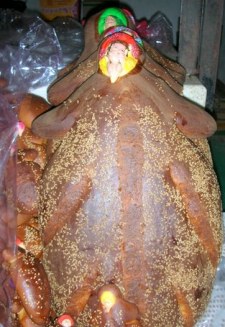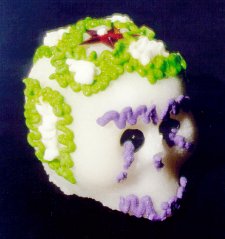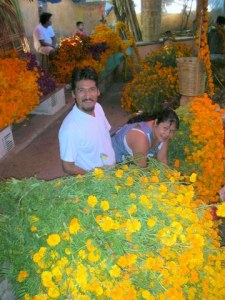
pan de muerto photo from Sheila Clarke

sugar skull

flower vendors photo from Sheila Clarke
|
 pan de muerto photo from Sheila Clarke  sugar skull  flower vendors photo from Sheila Clarke |
El Día de Los Muertos originated in Mexico, before the Spanish conquest. The exact date is unknown but it has been speculated that the idea originated with the Olmecs, possibly as long as 3000 years ago. This concept was passed to other cultures such as the Toltecs, Maya, Zapotec, Mixtec and Aztecs. Zapotec and Mixtec influence are strong in Oaxaca, see Linguistic map. The Aztec celebration was held during the Aztec month of Miccailhuitontli, presided over by the goddess Mictecacihuatl Lady of the Dead, and dedicated to children and the dead. Following the Spanish conquest of Mexico during the 16th century, there was a strong effort to convert the native population to Catholicism. There was a good deal of reluctance on the part of the indigenous people which resulted in a blending of old customs with the new religion. All Saints' Day and All Hallows Eve (Halloween) roughly coincided with the preexisting Día de Los Muertos resulting in the present day event which draws from both. This "compromise" was necessary both to preserve church membership and to satisfy church authorities that progress was being made in converting the indigenous to Catholicism. Although the skeleton is a strong symbol for both Halloween and los Días de Los Muertos, the meaning is very different. For Días de Los Muertos the skeleton represents the dead playfully mimicking the living and is not a macabre symbol at all.
Preparation begins weeks in advance when statues, candies, breads and other items to please the departed are sold in markets. A sweet bread, pan de muerto, with decorations representing bones of the deceased is very popular as are sugar skulls. [see recipe for sugar skulls] All sorts of art objects and toys which symbolically represent death in some way are created and marketed. This gives the economy a boost in much the same way as the Christmas season does. Alters ofrecetas are set up in the home with offerings of sweets and the favorite foods and beverages of the deceased. These offerings may later be given away or consumed by the living after their essence has been enjoyed by the dead. Marigolds are the traditional decorative flower and fuchsias are also used for decoration. Spectacular displays of these flowers by markets and street vendors is common in the days preceeding Day of the Dead. Copal is the traditional incense made from the resin of the copal tree. Observance of the Day of the Dead can be quite an expense for poor families who may spend a significant portion of their annual income on the event. This is justified by the belief that good fortune will be enjoyed by those who make the spirits of the dead happy. Conversely the extravagance with which the period is celebrated is affected by the prevailing economic conditions.
The particulars of the celebration vary widely by region in Mexico. On November 1, Día de Muertos Chiquitos, the departed children are remembered. The evening is sometimes called la Noche de Duelo, The Night of Mourning, marked by a candlelight procession to the cemetery. On November 2, Día de los Muertos, the spirits of the dead return. Entire families visit the graves of their ancestors, bringing favorite foods and alcoholic beverages as offerings to the deceased as well as a picnic lunch for themselves. They spend the day cleaning and decorating the grave sites and visiting with each other and other families. Traditionally there is a feast in the early morning hours of November 2nd although many now celebrate with an evening meal. There are sugar skulls and toys for the children, emphasizing early on that death is a positive part of the life cycle. It is a happy occasion for remembering pleasant times with departed family members.
For more photos, see Gina's Day of the Dead Tour
and Michelle Mengel's photos of Día de los Muertos in Oaxaca City.
glossary